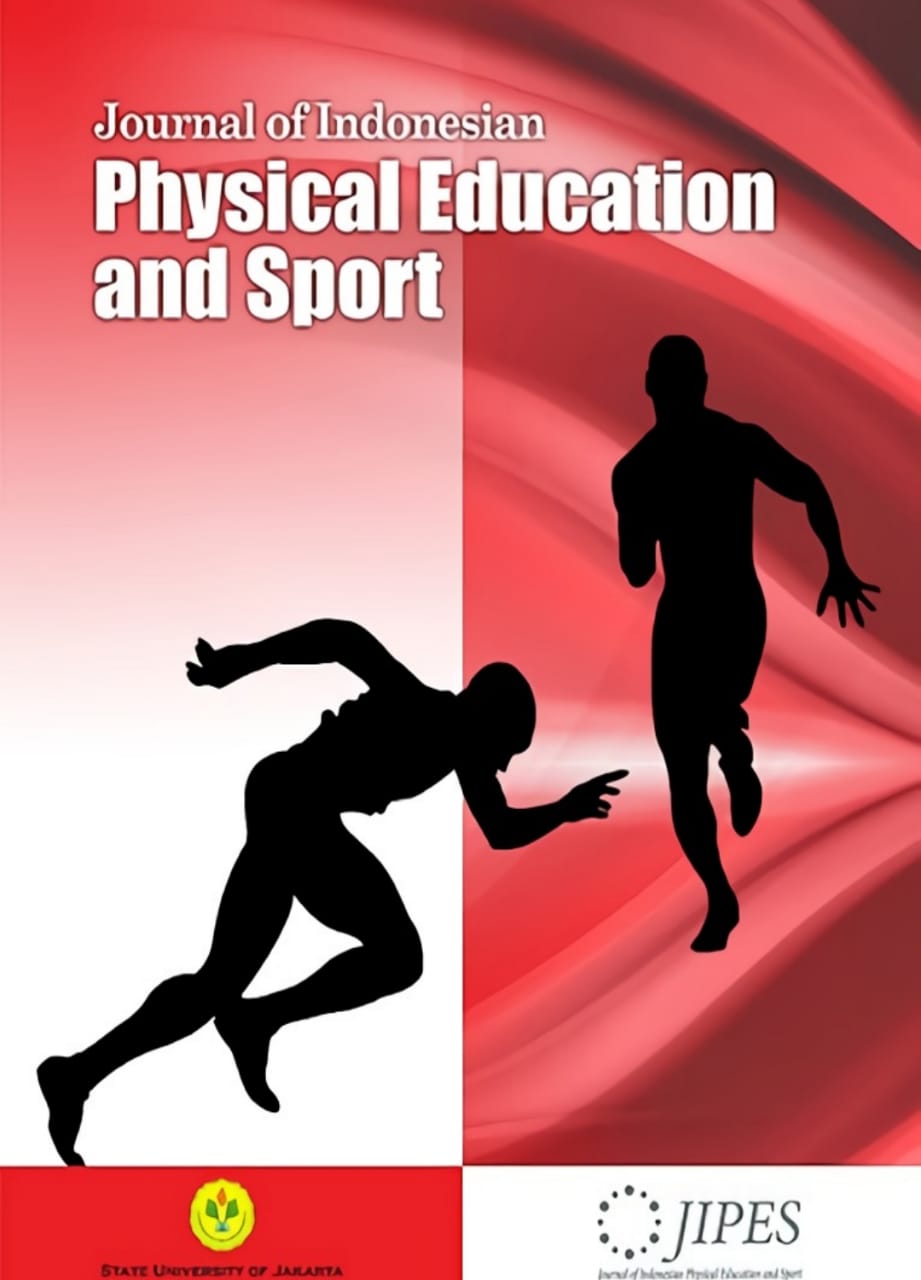Learning Outcomes of Sepak Sila Sepak Takraw Using Mosston's Teaching Style and Motor Ability Support
Learning Outcomes of Sepak Sila Sepak Takraw Using Mosston's Teaching Style and Motor Ability Support
Abstract
The purpose of this study was to determine the difference in the effect of reciprocal teaching styles and teaching styles practice on learning outcomes of basic sepak takraw techniques seen from the differences in students' high and low motor ability. The research method uses an experimental method with a factorial design 2 x 2. The sample in this study amounted to 40 students who were divided into four groups (A1B1, A2B1, A1B2, A2B2) each group consists of 10 people. The results of the study stated that there was a difference in the effect of reciprocal teaching styles with practice teaching styles on the learning outcomes of sepak sila in groups of students who had high motor ability. There is a difference in the effect of reciprocal teaching styles with practical teaching styles on learning outcomes of basic sepak sila techniques in groups of students who have low motor ability. There is an interaction between teaching style and motor ability on student learning outcomes
References
Byra, M., & Jenkins, J. (2000). Matching instructional tasks with learner ability: Inclusion style of teaching. Journal of Physical Education, Recreation, and Dance, 71(3), 26–30.
Byra, M., & McCullick, B. (2002). Spectrum teaching styles and the national s tandards for physical education: Introduction. Teaching Elementary Physical Education, 13(2), 6–7.
Chatoupis, C. (2005). Effects of Practice And Inclusion Styles On Perceived Athletic Competence Of Greek Primary School Children. Studies in Physical Culture and Tourism, 12(1), 47–57. Čoh, M., Golubović, D. J., &
Bratić, M. (2004). Motor Learning In Sport. Physical Education and Sport, 2(1), 45–49. https://doi.org/10.1007/BF00303591
Cothran, D. J., Kulinna, P. H., Banville, D., Choi, E., Macphail, A., Macdonald, D., … Sarmento, P. (2005). A Cross-Cultural Investigation of the Use of Teaching. Research Quarterly for Exercise and Sport, 76(2), 193–201. https://doi.org/10.1080/02701367.2005.10599280
Edwards, W. H. (2010). Motor Learning and Control From Theory to Practice.
Wadsworth: CENGAGE Learning.
H.Z., Z., R.W., L., W., L., & W., B. (2009). Learning outcomes taught by three t eaching styles in college fundamental volleyball classes. Clinical Kinesiology, 63(1), 1–6.
Harsono. (2015). Kepelatihan Olahraga. Bandung: PT Raja Grafindo.
Hattie, J. (2012). Visible Learning for Teachers: Maximizing Impact on Learning. The Main Idea. London: UK:Routledge. Retrieved from www.TheMainIdea.net
Hennings, J., Wallhead, T., & Byra, M. (2010). A Didactic Analysis of Student Content Learning During the Reciprocal Style of Teaching. Journal of Teaching in Physical Education, 29(3), 227–244. https://doi.org/10.1123/jtpe.29.3.227
Jaakkola, T., & Anthony, W. (2011). Finnish Physical Education Teachers’ Self- Reported Use and Perceptions of Mosston and Ashworth’s Teaching Styles. Journal of Teaching in Physical Education, 30(3). https://doi.org/10.1123/jtpe.30.3.248
Magil, R. A. (2007). Motor Learning and Control. New York: McGraw-Hill. Magil, R., & Anderson, D. (2014). Motor Learning and Control, Concept and Application. Amerika: McGraw-Hill.
Mosston, M., & Ashworth, S. (2008). Teaching Physical Education. New York: Mac Millan College Publishing Inc.
Nurhasan, & Hasanudin. (2007). Modul Tes dan Pengukuran Keolahragaan.
Bandung: FIK UPI.
Pitsi, A., Digelidis, N., & Papaioannou, A. (2015). The Effects Of Reciprocal And Self–Check Teaching Styles In Students’ Intrinsic– Extrinsic Motivation, Enjoyment And Autonomy In Teaching Traditional Greek Dances. Journal of Physical Education and Sport, 15(2), 352–361. https://doi.org/10.7752/jpes.2015.02053
Prasetyo, Y. E. (2013). Survei Penggunaan Gaya Mengajar Yang Digunakan Oleh Guru Penjas SD Negeri Se- Kecamatan Tulung Kabupaten Klaten. Skripsi: Prodi Pendidikan Guru Sekolah Dasar Penjas Pendidikan Olahraga Fakultas Ilmu Keolahragaan Universitas Negeri Yogyakarata.
Rustaman. (2001). Keterampilan Bertanya dalam Pembelajaran IPA.”dalamHandout Bahan Pelantikan Guru-Guru IPA SLTP Se-Kota Bandung di PPG IPA. Jakarta: Depdiknas.
Setiawan, R. A. B., & Nopembri, S. (2013). Penggunaan Gaya Mengajar “ Mosston ” Oleh Guru Pendidikan Jasmani Di Sma Se-Kota Yogyakarta. Jurnal Pendidikan Jasmani Indonesia, 9(1), 7–14.
Syrmpas, I., & Digelidis, N. (2014). Physical education student teachers’ experiences with and perceptions of teaching styles. Journal of Physical Education and Sport, 14(1), 52–59. https://doi.org/10.7752/jpes.2014.01009
Tones, S., Jones, L., & Keskitalo, V. (2011). Tiered Reciprocal Learning and Teaching in the Context of Physical Education Teacher Education (PETE). In AIESEP 2011 International Conference University of Limerick. (pp. 132– 137). Ireland.
Verducci, F. R. (1989). Measurement Concep in Physical Education. St. Louis Missouri: Mosby Company.










 </a > a
</a > a 